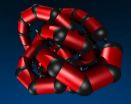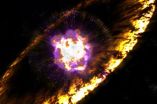(Press-News.org) This press release is available in German.
Physicists of the University of Vienna together with researchers from the University of Natural Resources and Life Sciences Vienna developed nano-machines which recreate principal activities of proteins. They present the first versatile and modular example of a fully artificial protein-mimetic model system, thanks to the Vienna Scientific Cluster (VSC), a high performance computing infrastructure. These "bionic proteins" could play an important role in innovating pharmaceutical research. The results have now been published in the renowned journal "Physical Review Letters".
Proteins are the fundamental building blocks of all living organism we currently know. Because of the large number and complexity of bio-molecular processes they are capable of, proteins are often referred to as "molecular machines". Take for instance the proteins in your muscles: At each contraction stimulated by the brain, an uncountable number of proteins change their structures to create the collective motion of the contraction. This extraordinary process is performed by molecules which have a size of only about a nanometer, a billionth of a meter. Muscle contraction is just one of the numerous activities of proteins: There are proteins that transport cargo in the cells, proteins that construct other proteins, there are even cages in which proteins that "mis-behave" can be trapped for correction, and the list goes on and on. "Imitating these astonishing bio-mechanical properties of proteins and transferring them to a fully artificial system is our long term objective", says Ivan Coluzza from the Faculty of Physics of the University of Vienna, who works on this project together with colleagues of the University of Natural Resources and Life Sciences Vienna.
VIDEO:
This is an animation of the folding pathway.
Click here for more information.
Simulations thanks to Vienna Scientific Cluster (VSC)
In a recent paper in Physical Review Letters, the team presented the first example of a fully artificial bio-mimetic model system capable of spontaneously self-knotting into a target structure. Using computer simulations, they reverse engineered proteins by focusing on the key elements that give them the ability to execute the program written in the genetic code. The computationally very intensive simulations have been made possible by access to the powerful Vienna Scientific Cluster (VSC), a high performance computing infrastructure operated jointly by the University of Vienna, the Vienna University of Technology and the University of Natural Resources and Life Sciences Vienna.
Artificial proteins in the laboratory
The team now works on realizing such artificial proteins in the laboratory using specially functionalized nanoparticles. The particles will then be connected into chains following the sequence determined by the computer simulations, such that the artificial proteins fold into the desired shapes. Such knotted nanostructures could be used as new stable drug delivery vehicles and as enzyme-like, but more stable, catalysts.
INFORMATION:
This project was supported by the Austrian Science Fund (FWF) within the SFB "Vienna Computational Materials Laboratory" (ViCoM).
Publication in Physical Review Letters
Sequence Controlled Self-Knotting Colloidal Patchy Polymers: Ivan Coluzza, Peter D. J. van Oostrum, Barbara Capone, Erik Reimhult, and Christoph Dellago. February 11, 2013.
http://prl.aps.org/abstract/PRL/v110/i7/e075501
Nano-machines for 'bionic proteins'
2013-02-15
ELSE PRESS RELEASES FROM THIS DATE:
Study finds possible link between diabetes and increased risk of heart attack death
2013-02-15
Having diabetes doubles a person's risk of dying after a heart attack, but the reason for the increased risk is not clear. A new University of Iowa study suggests the link may lie in the over-activation of an important heart enzyme, which leads to death of pacemaker cells in the heart, abnormal heart rhythm, and increased risk of sudden death in diabetic mice following a heart attack.
"Many studies have shown that patients with diabetes are at especially high risk for dying from a myocardial infarction (heart attack). Our study provides new evidence that this excess ...
Wild plants are infected with many viruses and still thrive
2013-02-15
UNIVERSITY PARK, PA. -- Researchers have studied viruses as agents of disease in humans, domestic animals and plants, but a study of plant viruses in the wild may point to a more cooperative, benevolent role of the microbe, according to a Penn State virologist.
"Most of these wild plants have viruses," said Marilyn Roossinck, professor of plant pathology and environmental microbiology and biology, who has examined more than 7,000 individual plants for viruses. "But they don't have any of the symptoms that we usually see in crop plants with viruses."
Most of the viruses ...
Technique that removes additional toxins prolongs dialysis patients' lives
2013-02-15
Highlights
A technique that removes additional toxins during dialysis decreased kidney failure patients' risk of dying from any cause by 30% over three years.
The technique also reduced patients' risk of dying from heart-related causes or infections.
15% to 25% of dialysis patients die annually.
Washington, DC (February 14, 2013) — A technique that removes additional toxins during dialysis may prolong kidney failure patients' lives, according to a clinical trial appearing in an upcoming issue of the Journal of the American Society Nephrology (JASN). In light of ...
Accelerated protons confirm origin of cosmic rays
2013-02-15
We are constantly being bombarded by speedy, energetic, and yet unassuming, particles called cosmic rays. These charged particles (mostly protons), continuously assail the Earth from outer space. There is general consensus among scientists that supernova remnants (the leftovers of a supernova explosion) are the sources of cosmic rays, but the final proof has been elusive since cosmic rays are deflected on their way from the source to Earth.
A new study offers conclusive evidence that cosmic ray protons within our galaxy are accelerated in the shock waves produced by ...
Fish become bolder and more gluttonous from drug residue
2013-02-15
Anxiety-moderating drugs that reach waterways via wastewater create fearless and asocial fish that eat more quickly than normal. These behavioral changes can have serious ecological consequences. This is shown by Umeå University researchers in the prestigious journal Science.
Many drugs leave our bodies unaffected, and residues from them are therefore found in wastewater. Low concentrations of drugs are often found downstream from sewage treatment plants. Today we test how dangerous drugs are to humans, but our knowledge of the environmental impacts of drugs is limited. ...
Mood-modifying drugs for humans also alter fish behavior
2013-02-15
Pharmaceutical drugs that end up in the world's waterways after being excreted, flushed and treated at wastewater treatment plants may lead to unexpected ecological impacts, according to a new study of wild European perch. Tomas Brodin and colleagues from Umeå University in Sweden discovered that the fish ate faster, became bolder and acted less social after being subjected to an anxiety-moderating drug, known as Oxazepam.
The psychiatric drug is used to treat anxiety in humans. But, Oxazepam residues often wind up in natural aquatic systems, downstream from sewage treatment ...
Proof: Cosmic rays come from exploding stars
2013-02-15
Menlo Park, Calif. — A new study confirms what scientists have long suspected: Cosmic rays – energetic particles that pelt Earth from all directions – are born in the violent aftermath of supernovas, exploding stars throughout the galaxy.
A research team led by scientists at the Kavli Institute for Particle Astrophysics and Cosmology at the Department of Energy's (DOE) SLAC National Accelerator Laboratory sifted through four years of data from NASA's Fermi Gamma-ray Space Telescope to find the first unambiguous evidence of how cosmic rays are born.
Reporting in the ...
Rapid changes in the Arctic ecosystem during ice minimum in summer 2012
2013-02-15
This press release is available in German.
Bremerhaven, 14 February 2013. Huge quantities of algae are growing on the underside of sea ice in the Central Arctic: in 2012 the ice algae Melosira arctica was responsible for almost half the primary production in this area. When the ice melts, as was the case during the ice minimum in 2012, these algae sink rapidly to the bottom of the sea at a depth of several thousands of metres. Deep sea animals such as sea cucumbers and brittle stars feed on the algae, and bacteria metabolise what's left, consuming the oxygen in the ...
Study of insomnia finds a new predictor for suicidal thoughts
2013-02-15
DARIEN, IL – A new study confirms a link between insomnia and thoughts of suicide and suggests that this relationship is mediated by dysfunctional beliefs and attitudes about sleep as well as nightmares. The study suggests that the targeted assessment and treatment of specific sleep problems may reduce the risk of suicide in people with depressive symptoms.
"Insomnia and nightmares, which are often confused and go hand-in-hand, are known risk factors for suicide but just how they contribute was unknown," said Dr. W. Vaughn McCall, the study's lead author and chair of ...
Trolls win: Rude blog comments dim the allure of science online
2013-02-15
BOSTON – The trolls are winning.
Pick a story about some aspect of science, any story, scroll down to the blog comments and let the bashing begin:
"Wonder how much taxpayer cash went into this 'deep' study?"
"I think you can take all these studies by pointy headed scientists, 99 percent of whom are socialists and communists, and stick them where the sun don't shine."
"Yawn. Climate change myth wackos at it again."
"This article is 100 percent propaganda crapola."
"Speaking of dolts, if you were around in the 70s, when they also had scientists, the big talk ...



